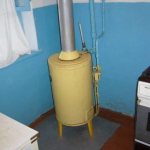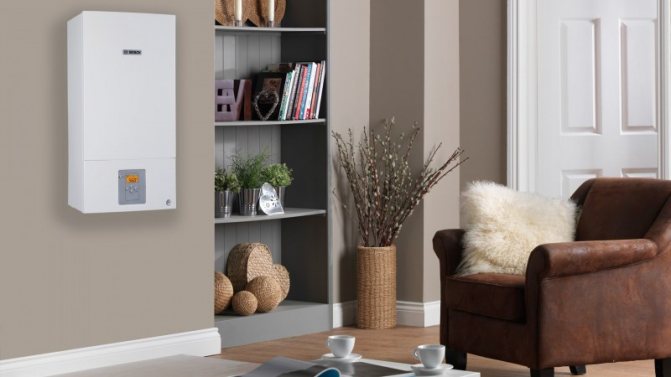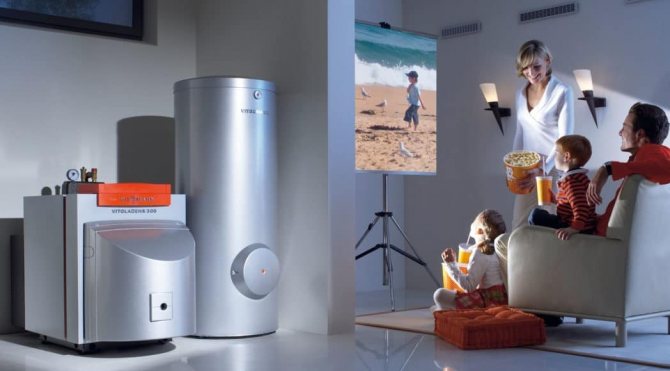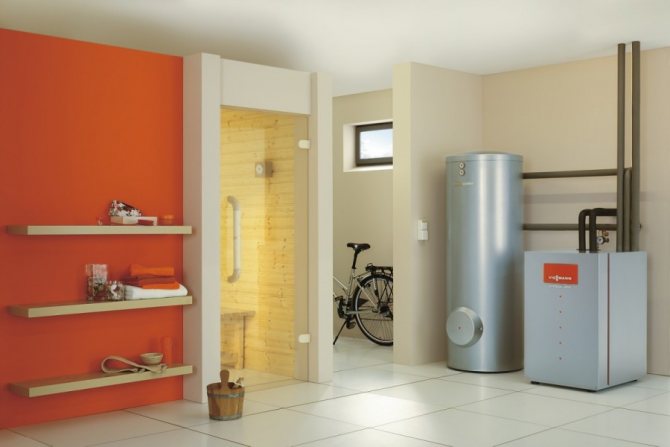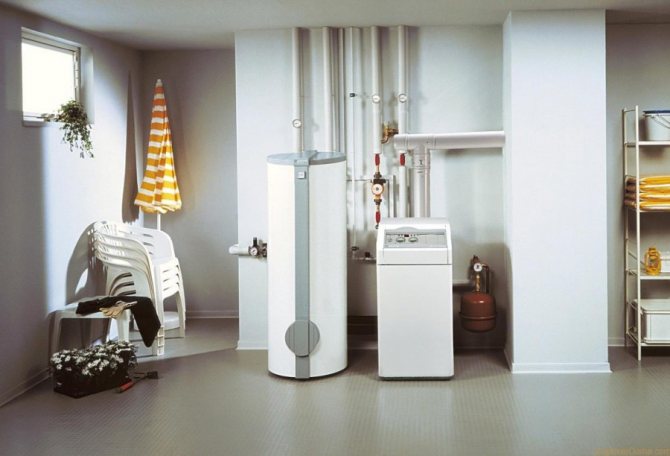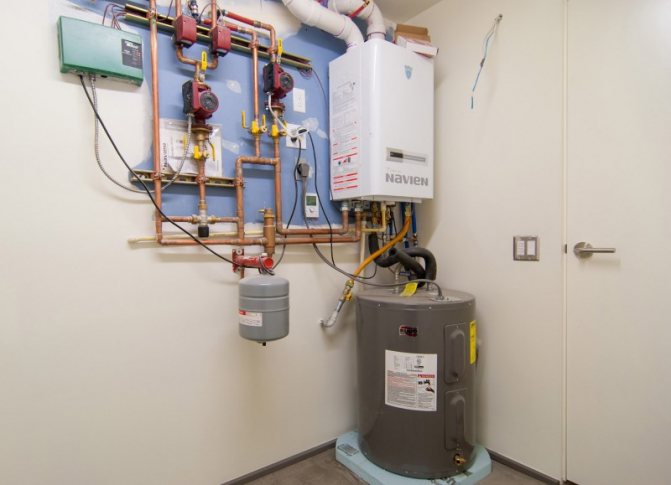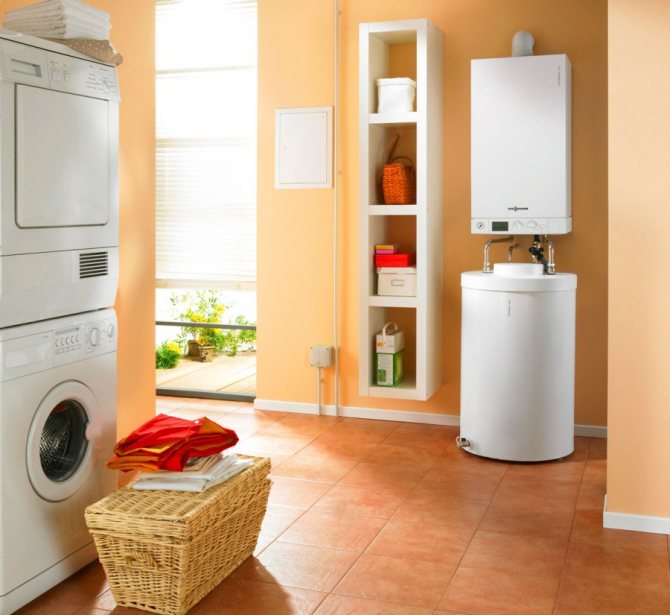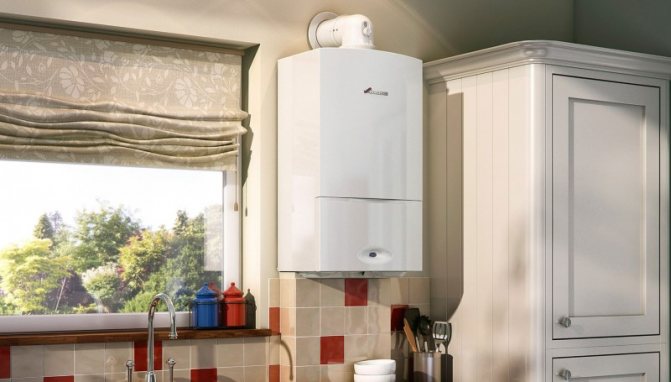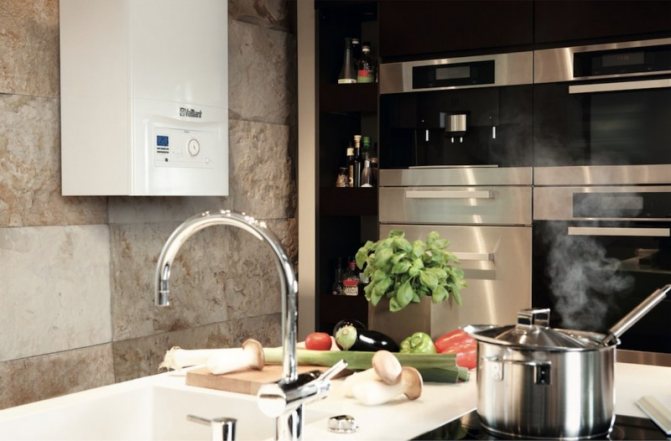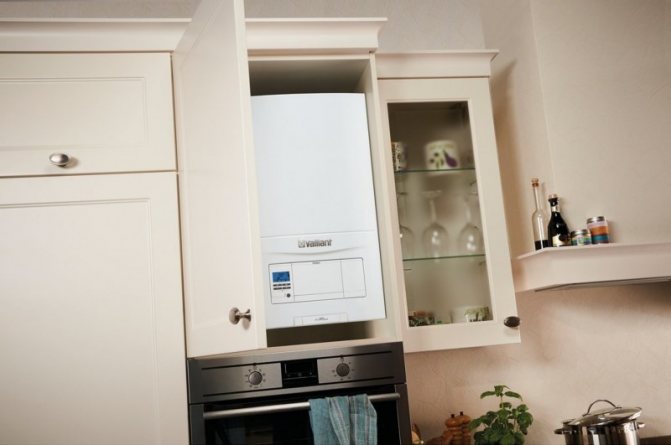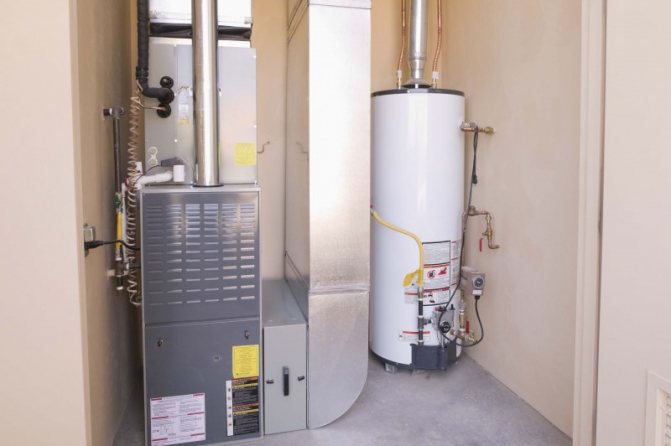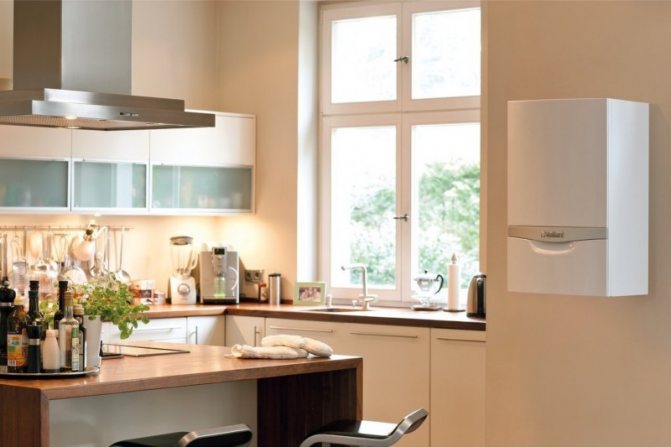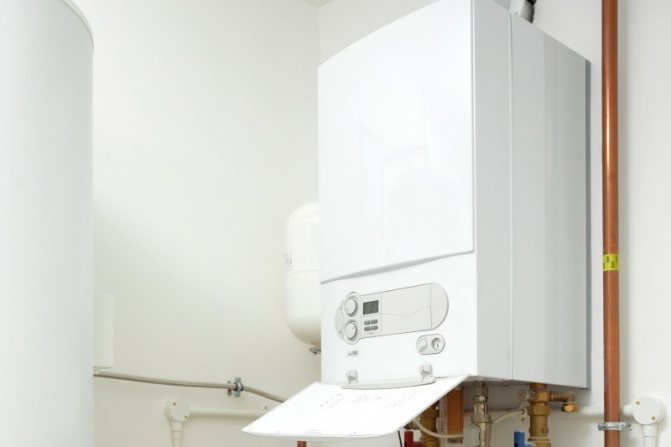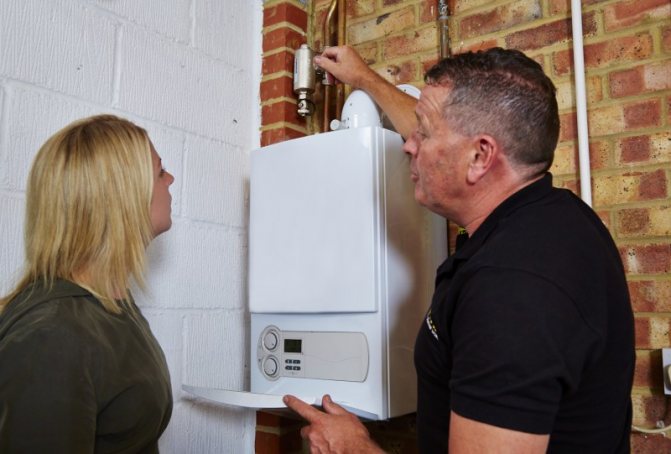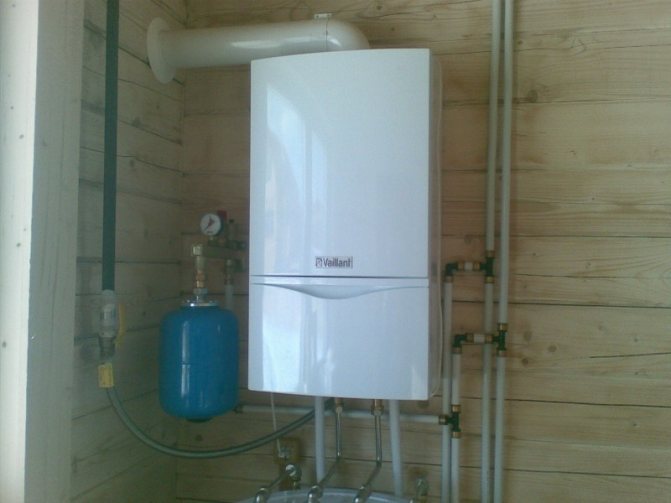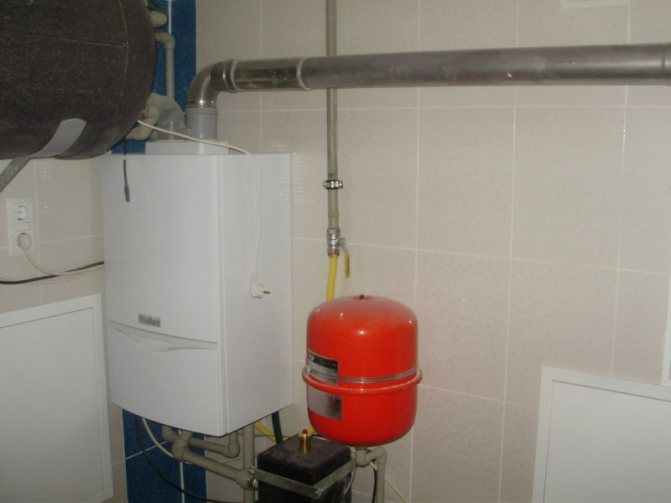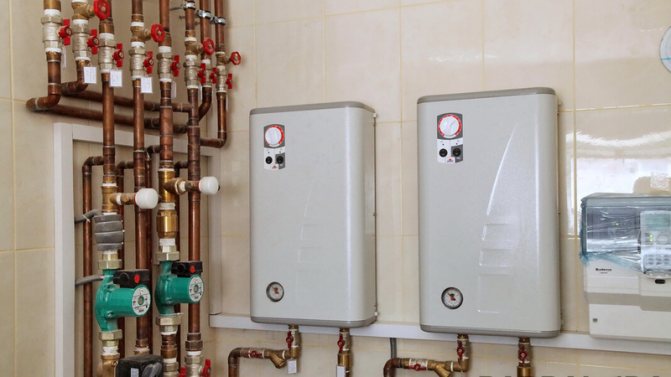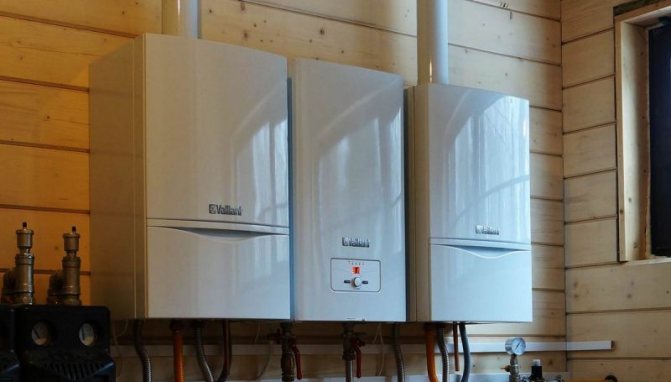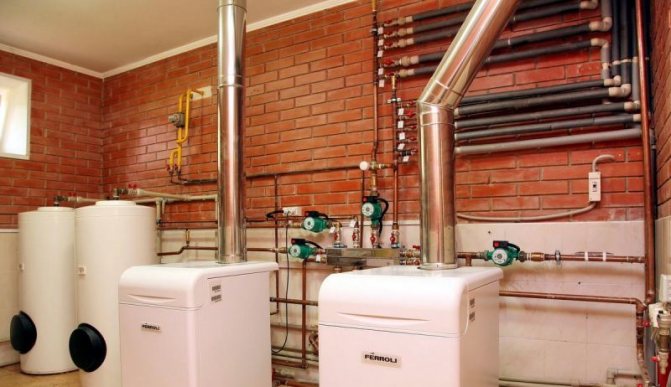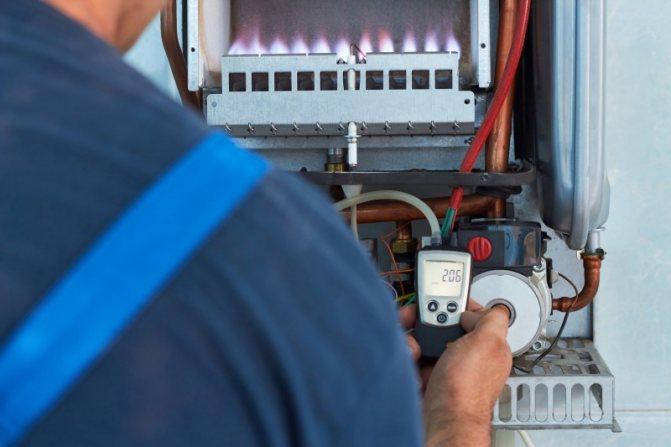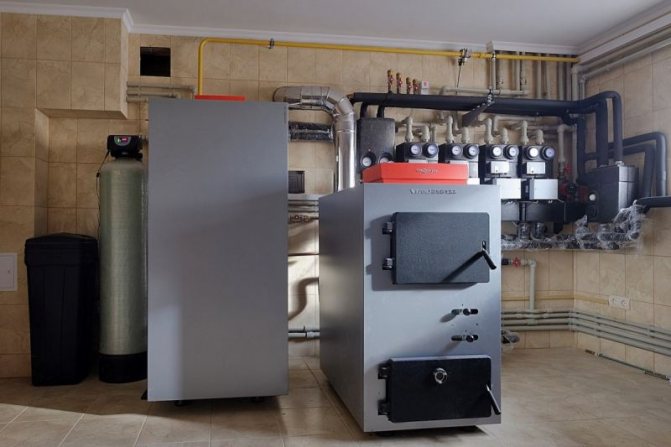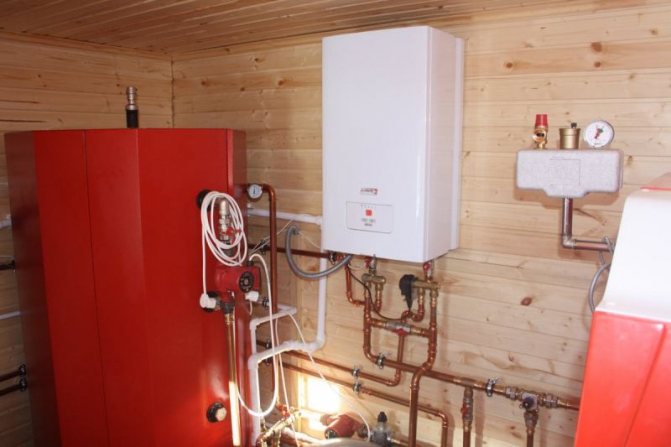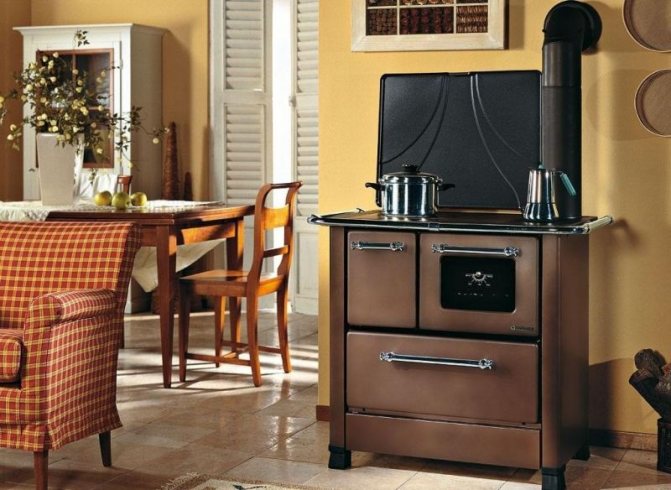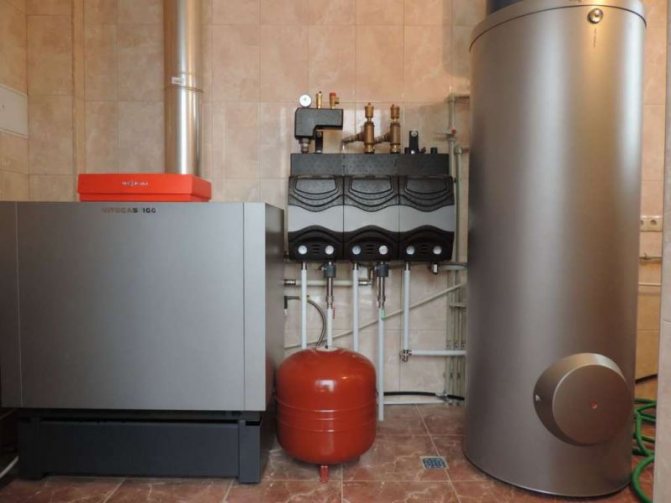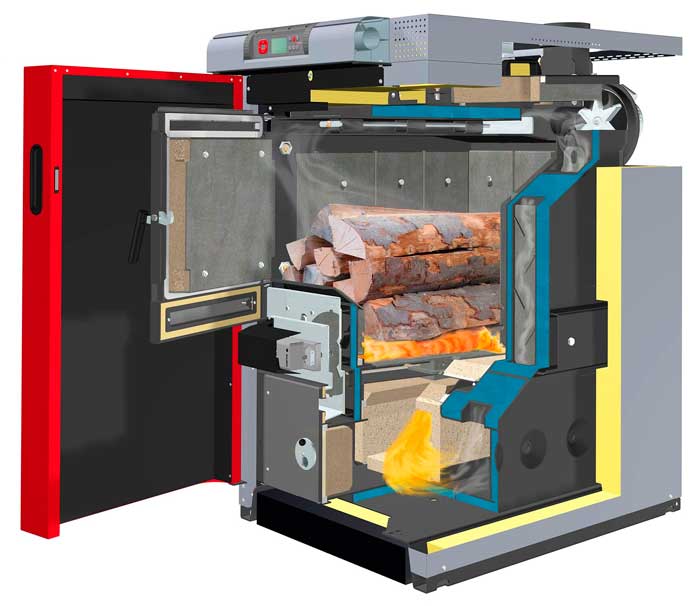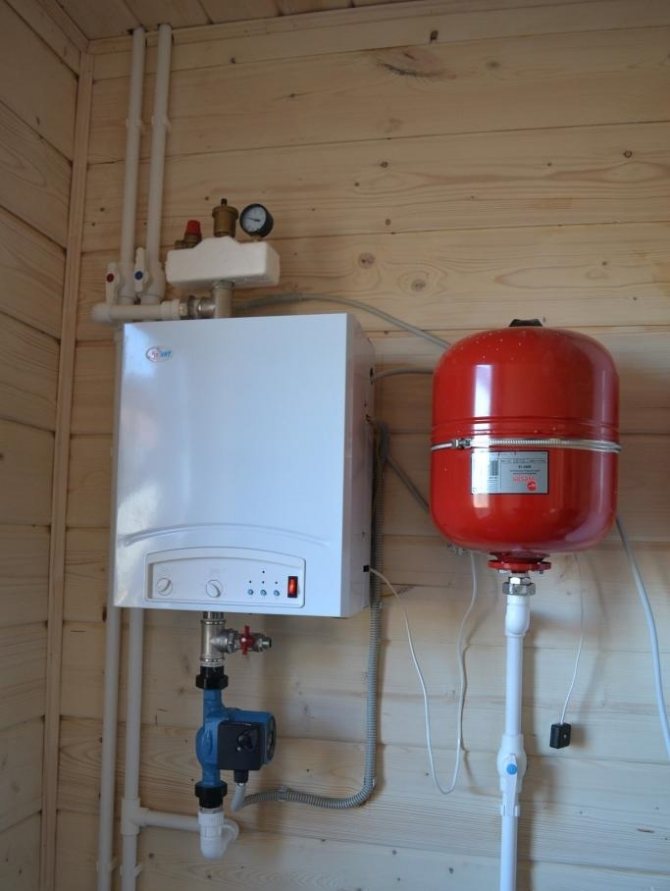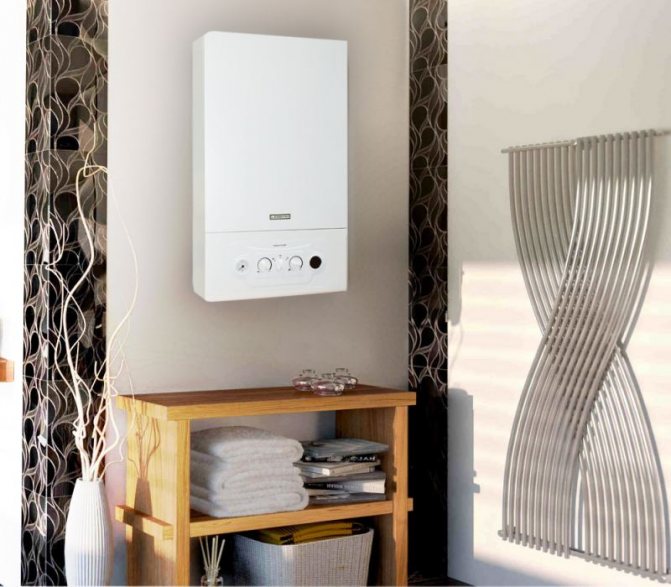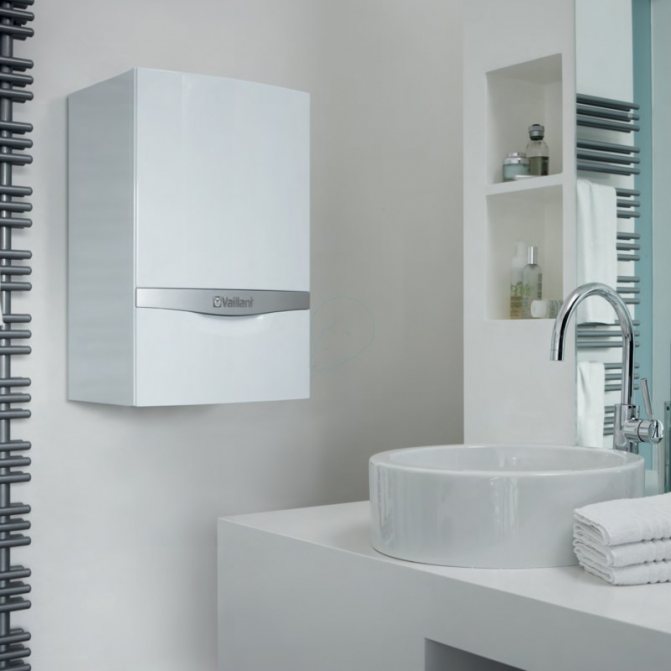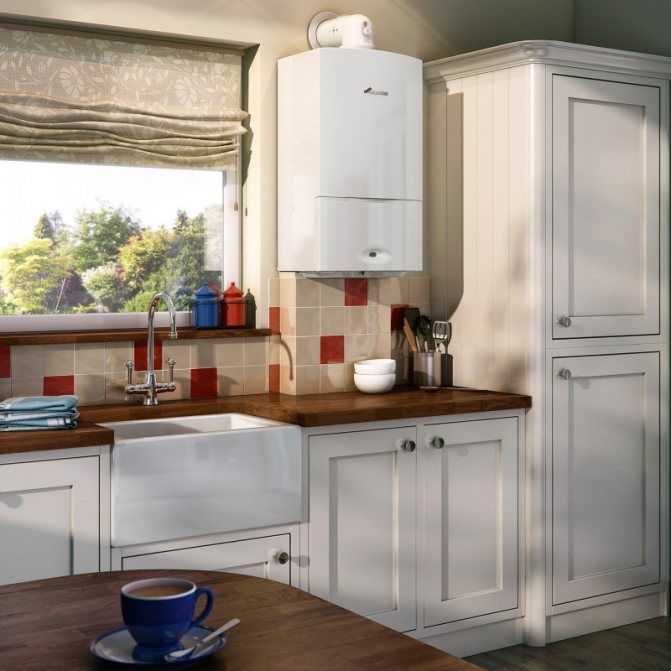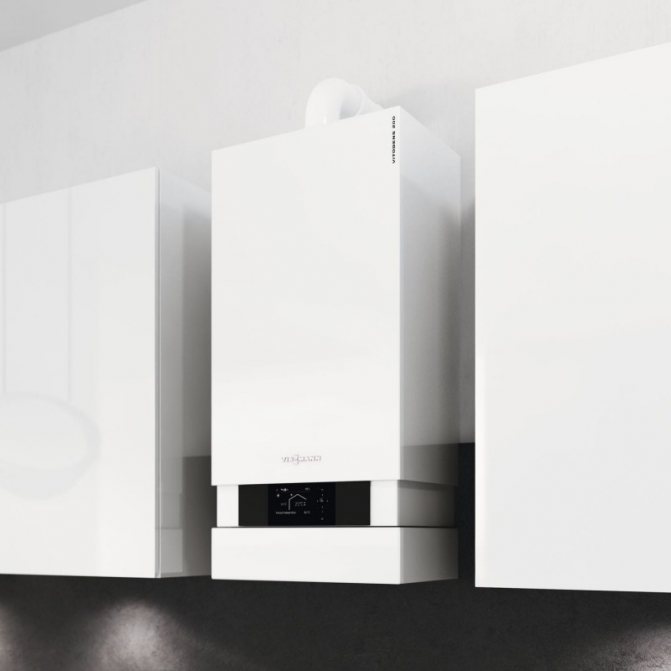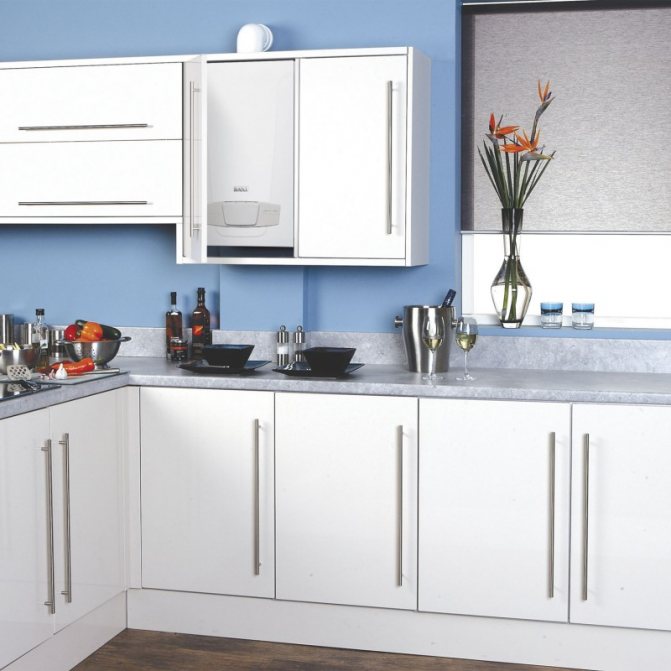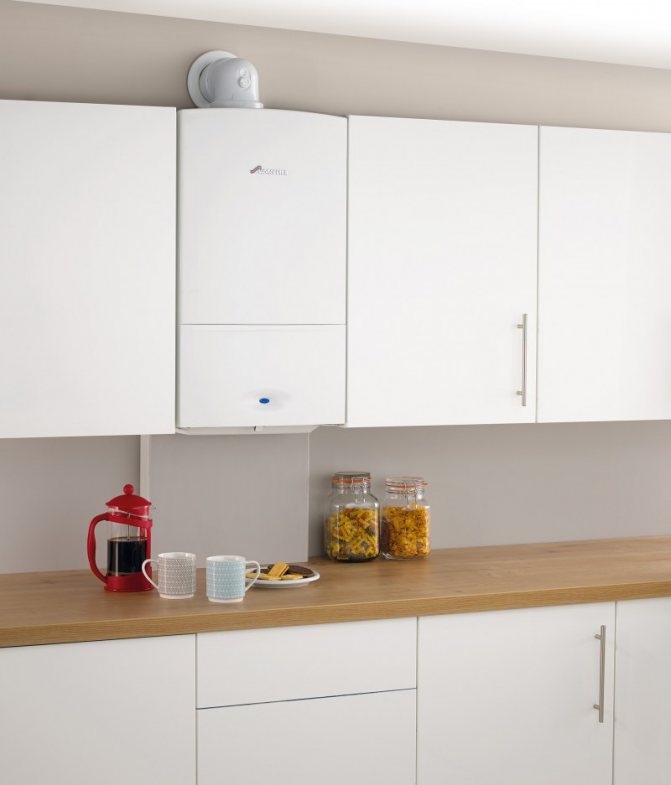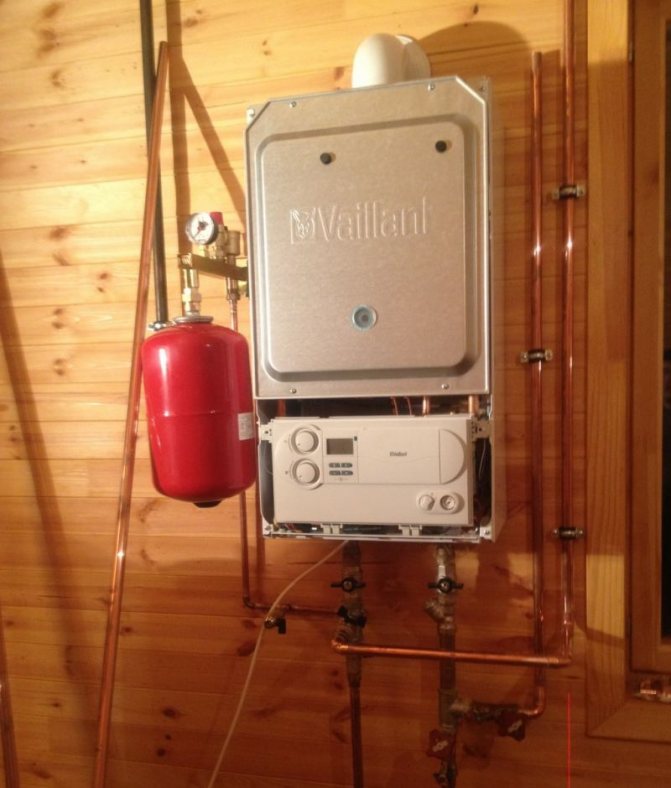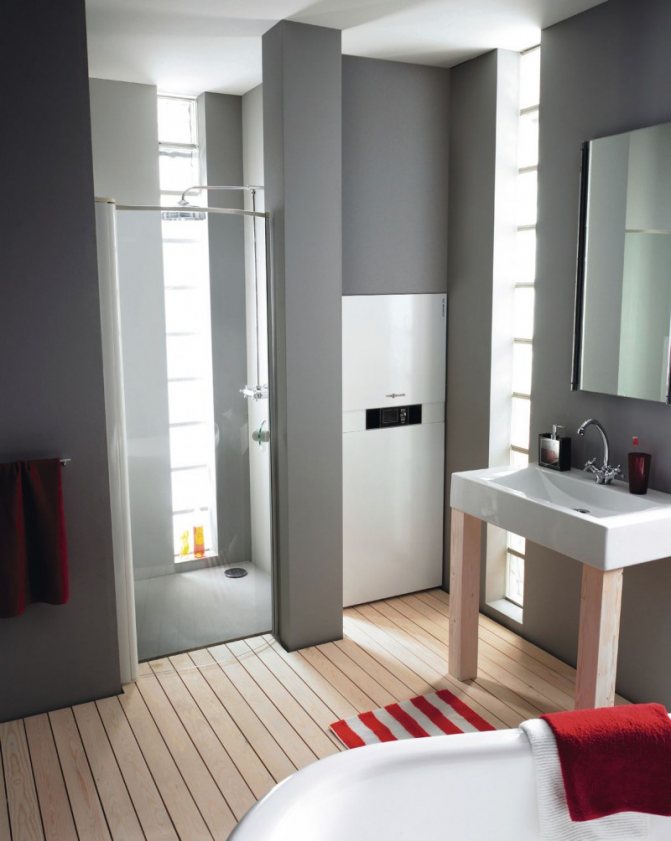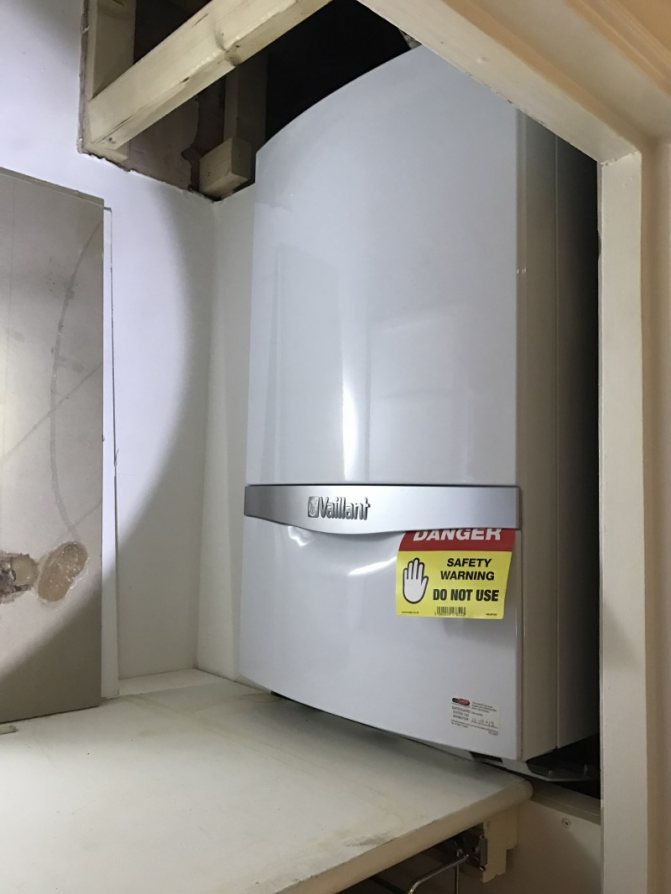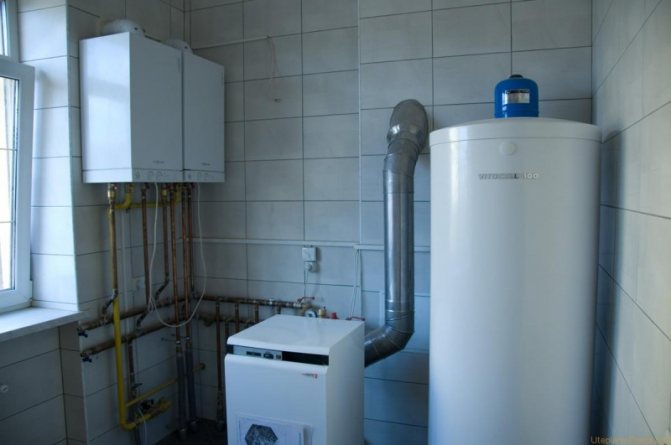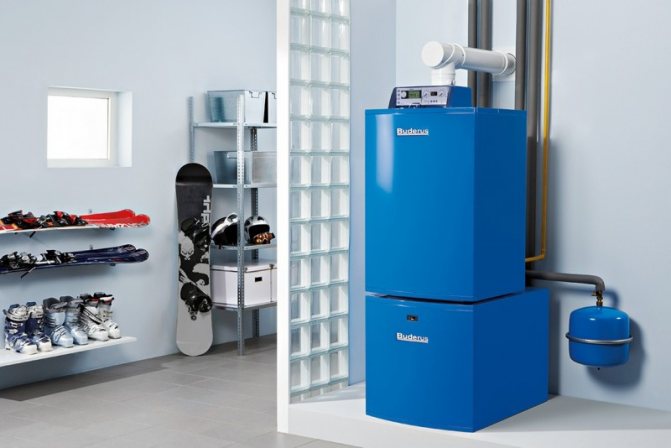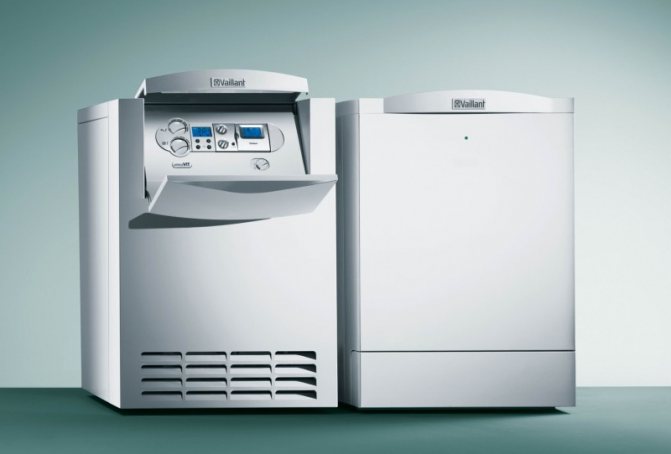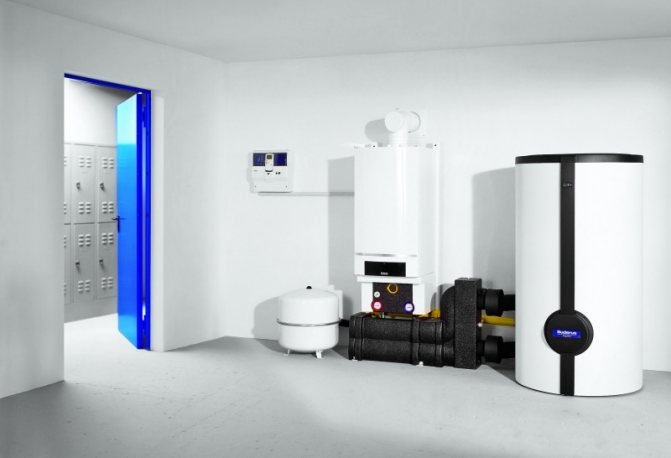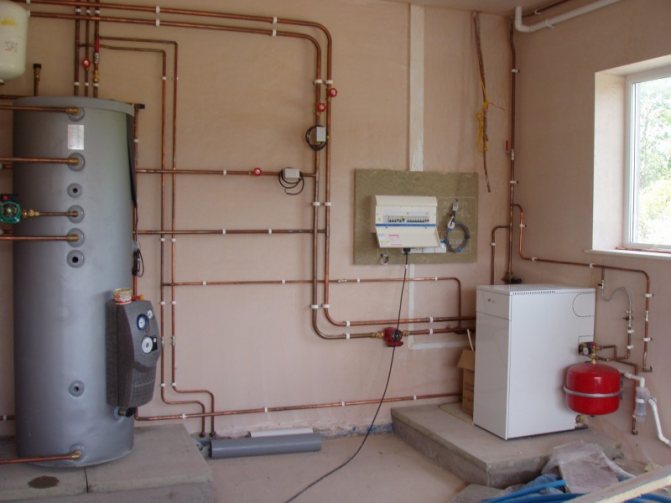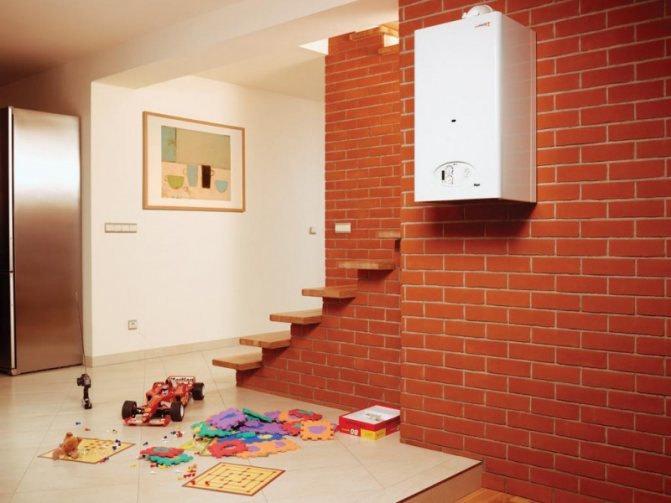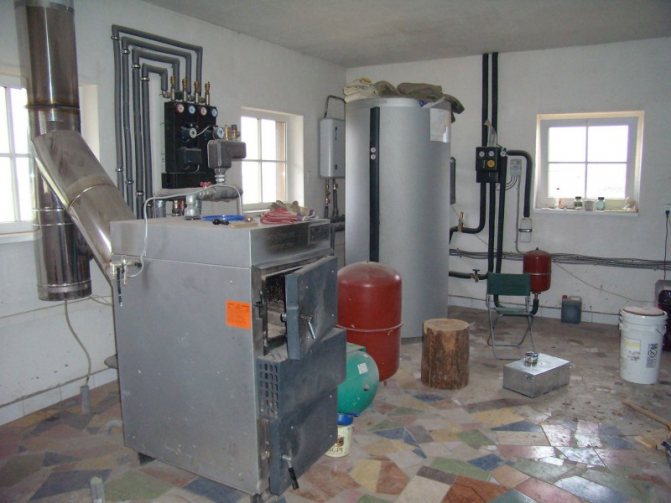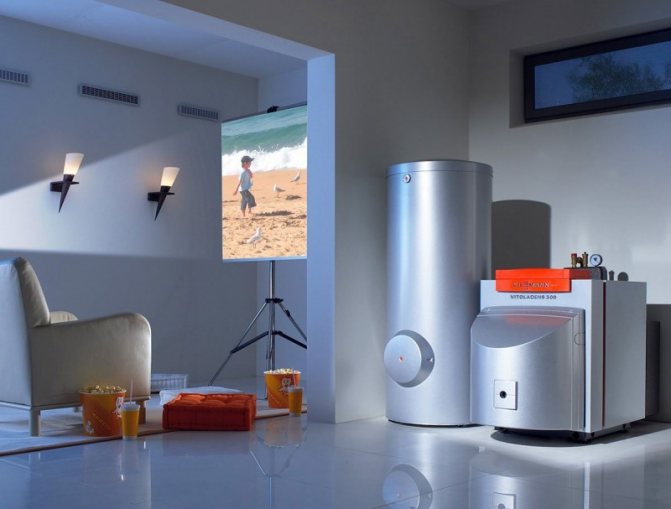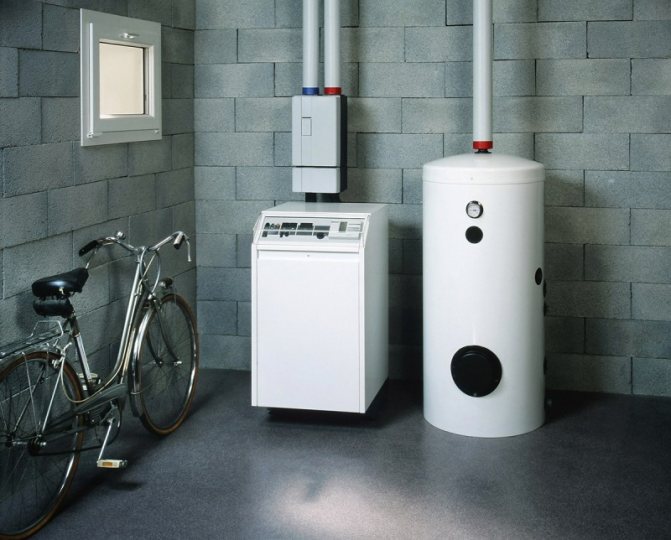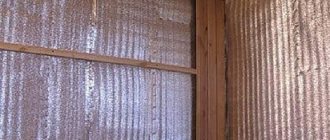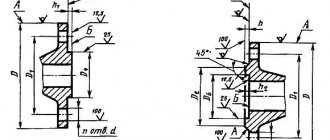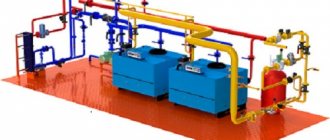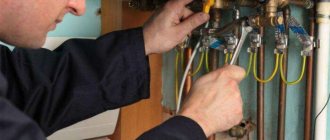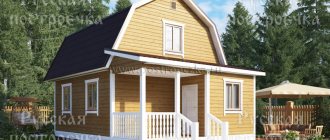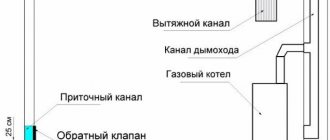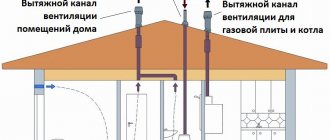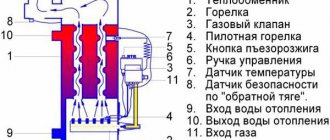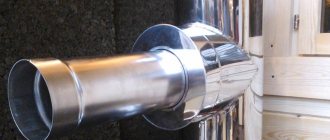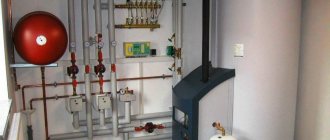Gas boilers have reliably taken their place among efficient, economical and non-volatile heating devices. The history of their use as a means for heating household premises, from the development of the structure to the modification of the last generation, goes back about 100 years. The difference between modern devices and old-style devices is visually and technically tangible and manifests itself in terms of power, durability, and external aesthetics.
Differ:
- boilers are old, distinguished by a primitive design;
- state-of-the-art gas apparatuses equipped with the latest energy-saving automatics;
- modified, combining the developments of the old years with new technologies.
Old cauldron
Varieties of boilers
A gas boiler for heating a private house can be made in various versions. Their types include:
The number of contours. Equipment with one circuit involved in the heating process. A boiler with two circuits is considered more efficient, where water is heated in parallel, which can be used for washing dishes and so on.
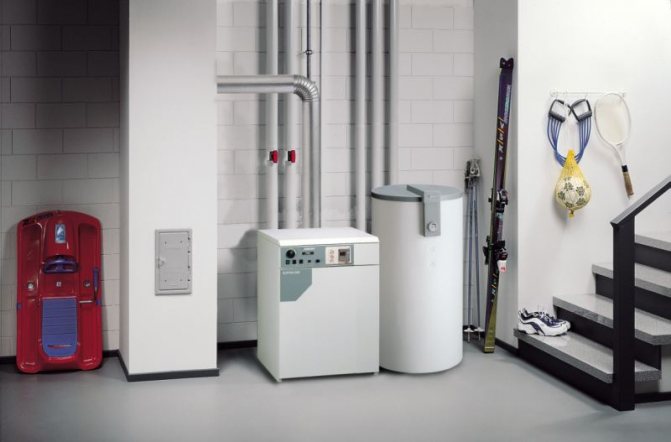
Mounting method. Simple structures are located on the floor and do not require additional equipment. More modern options are wall-mounted and require additional electrical equipment.
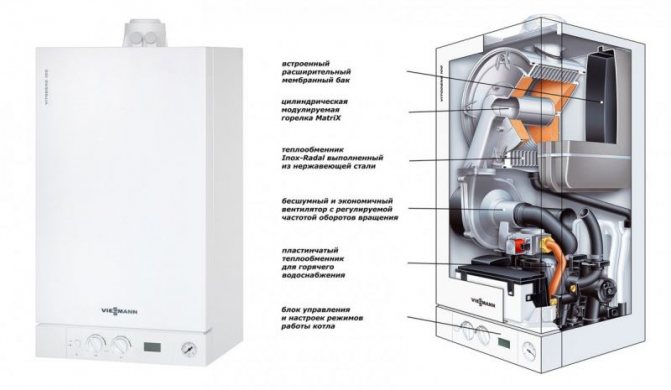

Dependent and independent from electrical power supply.
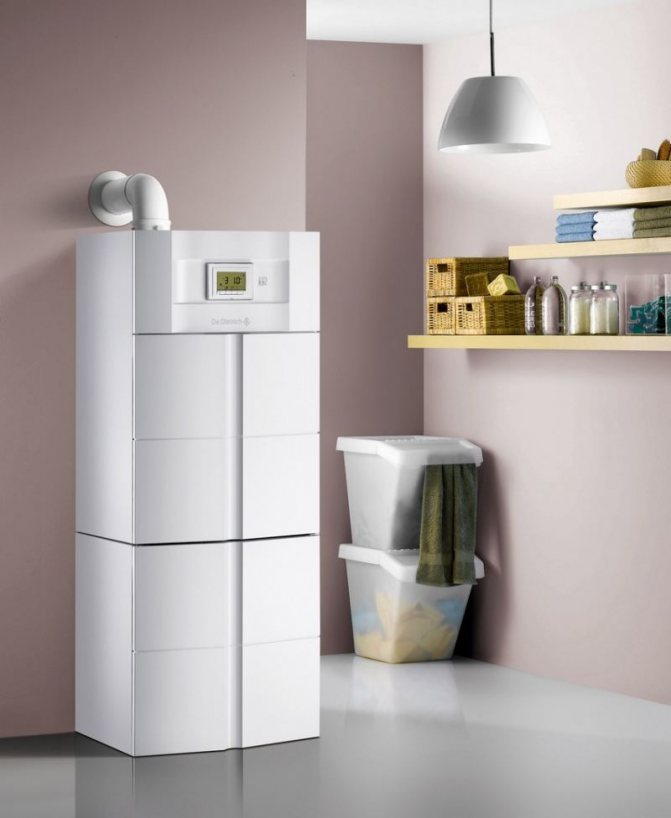

These are the main criteria for dividing gas equipment. The choice of a suitable product occurs in each case separately, it all depends on the parameters of the premises and the needs of the customer.
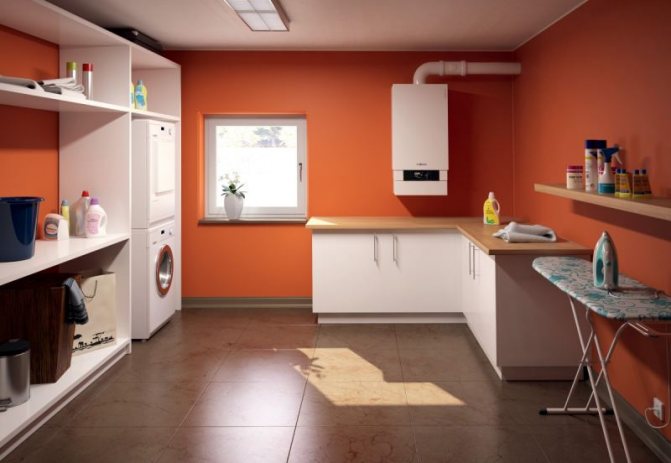

How to hide communications?
In addition to the gas boiler itself, it is necessary to hide all communications from the eyes. The pipe through which the gas is supplied to the boiler must not be bricked up in the wall. It is desirable if the rest of the pipes are within reach for their maintenance. If the communications are not covered, the view in the kitchen will be completely unaesthetic. To hide them externally, you can purchase special panels or a decorative box at a hardware store. Such a box is not very difficult to make on your own, then painting it to match the color of the interior or pasting it with a film to match the walls.
Advice. It is better if the decorative boxes are collapsible. Otherwise, they will have to be broken when it becomes necessary to access any section of communications.
You will also need to hide the chimney. To disguise it, you can make a decorative box with a heat-resistant inner surface or order a wall cabinet in the same style as the rest of the kitchen furniture. The material for the manufacture of the cabinet must also be resistant to heat, since the pipe for the removal of combustion products heats up.
There are quite a lot of different options for hiding a gas boiler in a kitchen area. Therefore, when buying this useful equipment, there should not be any problems, how to hide it from sight and not spoil the interior of the kitchen with the appearance of the unit.
How to mount a boiler in the kitchen: video
How to hide a boiler in the kitchen: photo
The cost
The price of gas boilers for heating a house depends on many parameters. These include:
- The efficiency of the device and its efficiency;
- power, dimensions and the need for additional equipment;
- brand awareness of the manufacturer and the seasonality of the purchase.
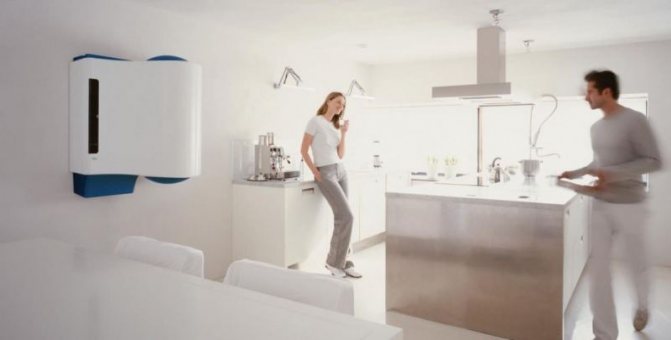

Before purchasing a gas heater, monitor the market in advance and select the right product for which you can find the necessary spare parts if it fails.
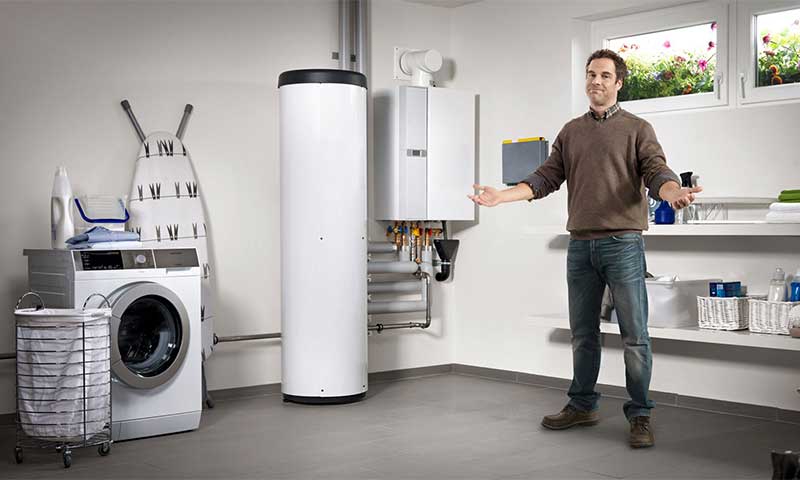

Heating boiler classification
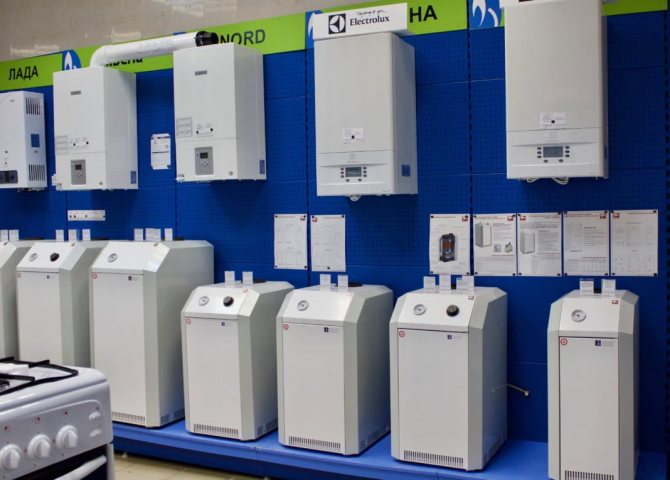

Boilers differ in the way of installation and the type of fuel used
Commercially available devices are sharpened for the use of different types of fuel. They differ in availability, cost and efficiency.
Gas
Gas fired boilers represent the largest market segment. This is due to the low price of this type of fuel in combination with good efficiency. Such a model can serve a large dwelling, in particular, work on two floors.
On sale you can find devices of two types of structures - floor and designed for wall mounting. Wall-mounted boilers are good for their compactness and completeness. In addition to the heat exchanger and the control unit, the housing of such a unit often contains additional components that optimize the functioning and make it safe. For a boiler placed on the floor, such equipment often has to be purchased separately. In this case, the total cost will be higher than the wall unit.
Both types of devices can have one or two circuits. Boilers of the first type are designed for use only for heating the premises.
Double-circuit installations are intended for residents who need hot water for domestic needs. Among such boilers, the best choice is the model equipped with a built-in boiler. It will provide residents with a supply of about 50 liters of heated water in case the gas supply is turned off.
Floor standing units can have a cast iron or steel heat exchanger. Steel products are lighter and less susceptible to shock during transportation, but more susceptible to corrosive effects. One of the subspecies of floor-standing devices is a parapet boiler with a closed combustion chamber, for the installation of which an ordinary chimney is not required. Features of its structure allow placement in a small room. However, such a device requires a gas supply and access to electricity to operate.
Solid fuel
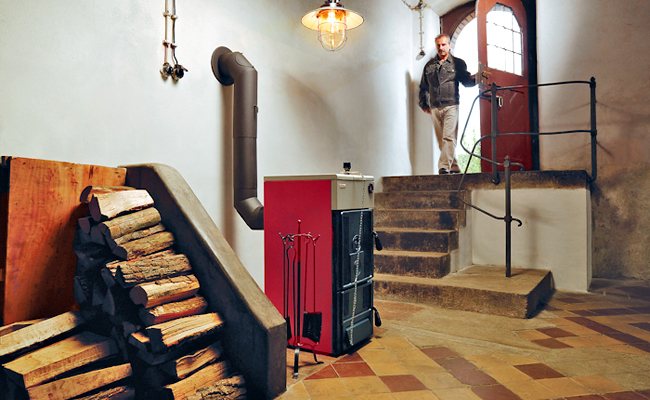

The temperature in the furnace depends on the type of fuel - coal, firewood, pellets, sawdust
Solid forms of fuel have been used by mankind for many centuries. Firewood, peat briquettes, lignite and hard coal fall into this category. The advantage is the possibility of creating a heating system that does not depend on the supply of gas and electricity. In areas where it is possible to provide the boiler with sufficient fuel resources, this option will be optimal. Some options have a long burning mode.
The following models are produced:
- Standard boilers that do not require an electrical connection. They can be designed for the operation of a certain type of solid fuel or work with different types of it. Temperature control is realized by means of sensors.
- Units with pyrolysis wood combustion. They burn not only the material itself, but also the wood gas produced in the process. They have good efficiency and are capable of heating a large room, but they require electricity.
- Devices capable of operating not only on solid, but also on other types of fuel.
On the market you can find models in steel and cast iron, with one and two circuits.
The downside of solid fuel boilers is that they require regular loading of new portions of firewood or coal.
Liquid fuel
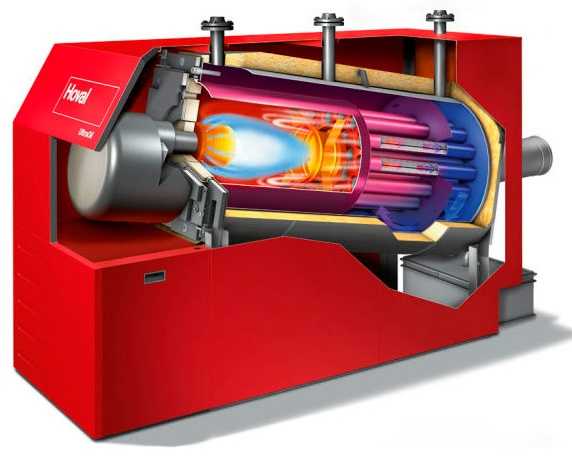

Oil-fired boiler
Most often, such devices run on diesel fuel. Sometimes fuel oil is also used, as well as technical oil that has worked out its due date or has become unsuitable for operation for its intended purpose. Such units are powerful and have high efficiency, due to which they are able to serve a spacious cottage building.Another plus is the relative cheapness of solar fuel compared to electricity. The downside is the need to install equipment in a special room equipped with an exhaust mechanism. In addition, the burner is quite noisy. When the fuel cools down and its temperature begins to approach zero, the wire must be artificially heated, otherwise the device will stop due to clogged filters.
Electrical
These devices are good for their compactness, complete structure, no need for a hood, burner, fuel tank. They do not generate emissions, do not require cleaning from fuel waste. An electric boiler can even be installed in the kitchen. The downside is that not all localities have access to sufficient electricity.
Combined
These units are capable of working with different types of fuel. One of the options is a combi boiler with a set of gas and liquid burners. It can be delivered in case of frequent interruptions in the operation of the gas pipeline, or in the case when it has not yet been laid, but it is planned to use it in the future. Some of these models are equipped with a heating element, which allows you to work on electricity. This segment of products is naturally the most expensive.


Electric
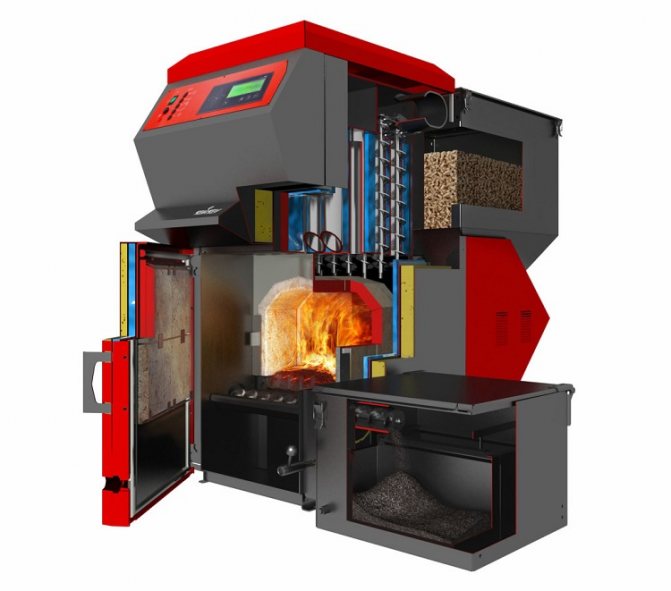

Combined
Efficient devices
Double-circuit gas boilers for home heating are very popular. This is due to their features:
- one burner simultaneously heats up two circuits, which saves energy resources;
- they take up little space and there is no need to install a gas water heater;
- this is a fairly effective and reliable equipment.
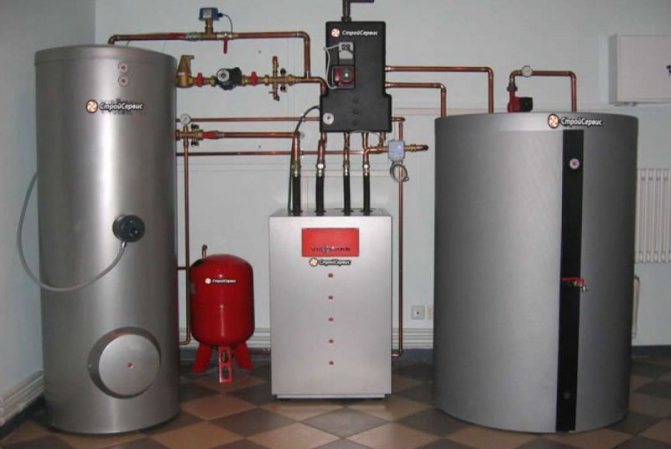

Double-circuit boilers are very popular, they cost a little more than standard equipment with one circuit, but they allow you to save money without buying a gas water heater.
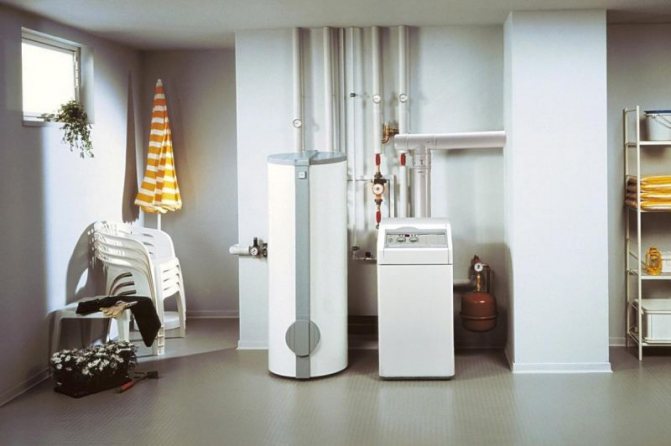

Examples of boiler lining schemes
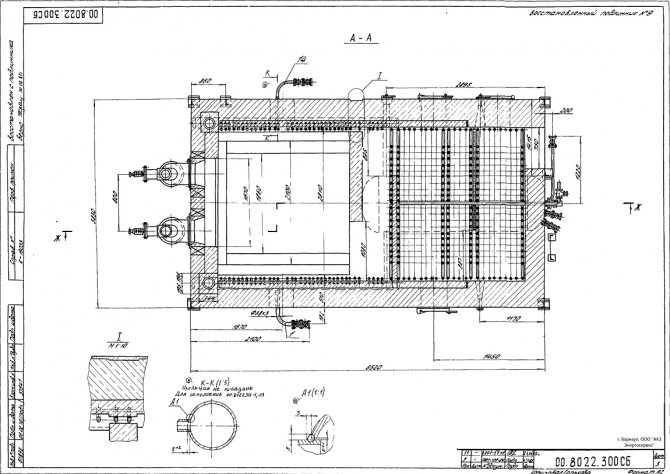

Drawing with the image of the specification of the boiler lining DKVr-6.5-13 GM (E-6.5-1.4GM).
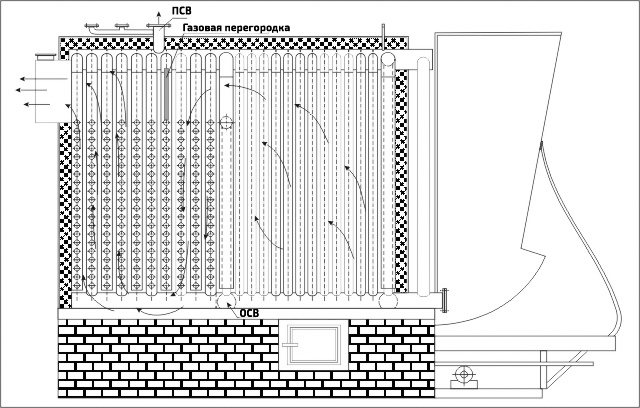

An example of a light lining diagram for a KVr series boiler.


An example of heavy lining of a KVr series boiler.
Which gas boiler is the best?
The best gas boiler for home heating must meet certain requirements. These include:
- economical consumption of energy resources;
- safety of equipment operation;
- production of a small amount of noise;
- simplicity of design and availability for repair;
- convenience in daily use.
Requirements and materials
The lining must be airtight and tight, be able to withstand prolonged high-temperature conditions, the chemical attack of ash, slag, smoke and other combustion products, be strong and stable, lightweight, accessible for repair, facilitate block assembly and dismantling of the boiler unit. The materials for lining the boiler are selected depending on the characteristics of the equipment and the type of construction.
Most often, lightweight or light lining is made, where fireclay brick is used as a refractory layer (lining). The seam between the rows of bricks should be as thin as possible - no more than 3 mm, preferably 1-2 mm. Therefore, the entire brick must be checked with a template, bricks with broken edges, any damage and irregularities on the surface must be rejected, it will not work to achieve a mandatory thin seam using it.
The outer layer can be made of ordinary red brick. External finishing is carried out by means of plastering or plastering, well-executed lining can be without external finishing, the main thing is that the temperature of its external surface during the operation of the boiler does not exceed 45 ° C.
When working in winter, only heated materials can be used: bricks and slabs from + 5 ° C, mortar from + 35-40 ° C.After finishing the lining work, it is imperative to dry the structure. Natural drying takes 10-12 days.
Purpose and methods of manufacturing an economizer for a heating boiler
The proportions of the mixture for lining the boiler
The solution must be prepared very carefully. When using fireclay bricks, it is made from refractory clay and fireclay powder. The proportions of the mixture of lining for the boiler are in the range of 20-40% refractory clay, 60-80% fireclay powder. The fatter the clay, the more powder you need. It is forbidden to add sand to the composition. To ensure thin seams, the mixture should be fairly fluid, approximately like sour cream in consistency.
For laying the facing layer (for example, from red brick), a solution of cement, lime and sand is used in a ratio of 1: 2: 5, respectively. For the foundation, it is better to keep the proportion 1: 2: 3 or 1: 2: 4.
Choosing the right gas boiler
Understanding the question: how to choose a gas boiler for heating a house - you will need to take into account some rules:
- initially it is necessary to determine the heated area of the room;
- it is important to foresee the local climate and possible heat losses;
- selection of equipment is based on 1 kW of boiler power per 10 m² of the area of the room;
- the boiler is selected with a power reserve of 25%, which allows it to be operated not at full capacity.
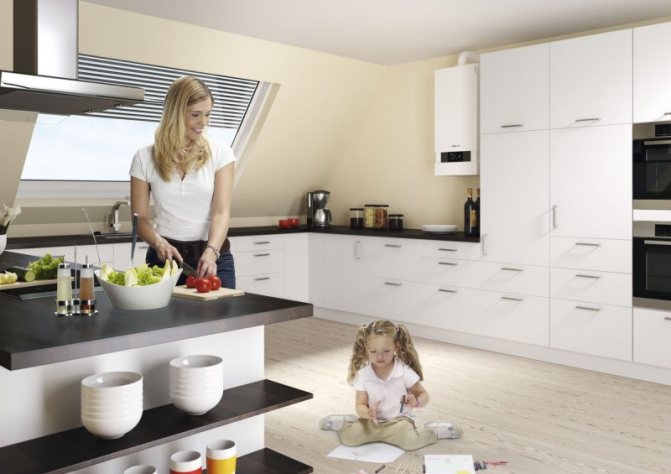

It is recommended to select equipment with the maximum possibility of smooth temperature control. It is better to purchase a two-stage boiler, which will allow using the equipment in two modes and significantly reduce energy costs.


Carefully study the technical characteristics of the gas boiler, this will make it possible to choose the right equipment and enjoy its trouble-free operation, while saving the family budget!
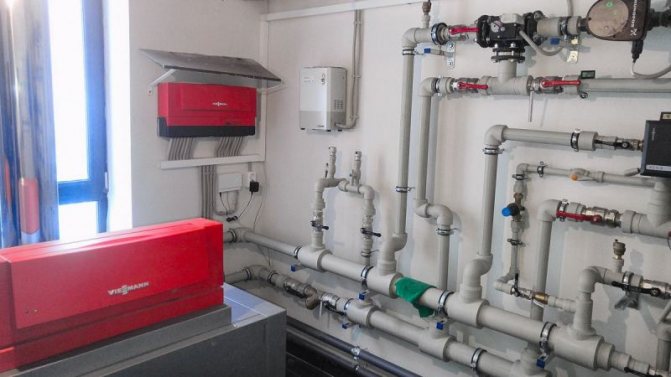

Varieties
Modern models of gas equipment are divided into several types. They differ among themselves according to the following criteria:
- Placement method. In this case, they are floor and wall;
- According to their technical characteristics, they are divided into single-circuit and double-circuit;
- According to the type of thrust, they are divided into natural and forced;
- Ignition method. In this case, the device of the model uses piezo ignition and electric ignition;
- By the type of energy released. Equipment can be convection and condensation. The photo of a gas boiler shows modern types of devices.
The last shots of the Great Patriotic War: the Courland Cauldron
On May 7, 1945, a preliminary protocol on the unconditional surrender of Nazi Germany was signed in Reims. On May 8 at 22:43 CET (in Moscow it was already May 9, 00:43) in the Karlshorst suburb of Berlin in the building of the former canteen of the military engineering school, the final Act of Germany's unconditional surrender was signed, the war in Europe was officially over. However, individual groups of Nazi troops continued to resist. So in the western part of Latvia - Courland, shots continued to be heard.
The Courland Cauldron (also known as the Courland Fortress or the blockade of the Courland Group of Forces) was formed in the fall of 1944, when the western part of Latvia (historically known as Courland) remained occupied by the troops of Nazi Germany. In Courland, the remnants of Army Group North were entrenched, which were caught between two Soviet fronts along the Tukums-Liepaja line. This encirclement was not a "cauldron" in full - the group of fascist troops was not completely blocked from the sea, so the troops surrounded here had the opportunity to communicate with Germany through the Baltic Sea, using the ports of Liepaja and Ventspils for this.Thus, it was possible to supply the grouping with food, ammunition, medicines, the wounded were evacuated by sea, and entire divisions were transferred from the grouping.
The German "Courland" army, became the last grouping of German troops on the territory of the Soviet Union, it was formed by units of the 16th and 18th German armies from the "North" army group, which were cut off from neighboring units from the "Center" army group to the end of October 10, when units of the 51st Soviet Army reached the Baltic coast in the area north of Palanga. At that time, the encircled group had about 30 incomplete divisions, the total number of the group was estimated at about 400 thousand people. At the time of Germany's surrender, there were still from 150 to 250 thousand soldiers and officers of the Nazi army here.
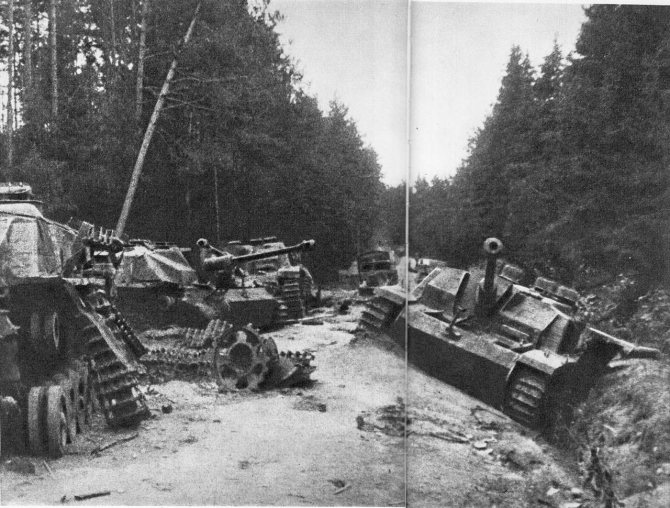

All these 30 German divisions remaining in Courland defended a relatively small front - about 200 kilometers, that is, one German division had 6.6 kilometers of front. Such a density of troops was more characteristic of divisions in preparation for an offensive than in defense. The Germans had the same high density of units during the Battle of Berlin at the Seelow Heights. But Berlin was the capital of Germany, a major transport and industrial hub, the political center of the state, and behind the 400-thousandth German group of troops in Courland there were two small seaports and just over 50 villages and farms located in wooded and swampy terrain. Despite this, the High Command of the German Army attached particular importance to this area, calling it a "bridgehead", "Baltic balcony", "external eastern fort of Germany", "breakwater". The order of the commander of the group Scherner said that "the defense of the Baltic is the best defense of East Prussia." Hitler allegedly believed that in the future his troops, which were blocked in western Latvia, could still be used for a decisive strike on the Eastern Front.
The two German armies retaining combat effectiveness could resist for a long time. They were well aware of the fact that the path of retreat to Northern Germany had already been cut off for them, so they were ready to fight with the bitterness of the doomed. At the final stage, command over the encircled group was taken over by Infantry General Karl August Hilpert, who became one of the main protagonists of the “North” group during the blockade of Leningrad. This German military leader had colossal experience, suffice it to say that he was in the army without interruption, starting in October 1907, and he was appointed to his last post after commanding the 16th Army. The rank of general was awarded to him on April 1, 1939. Karl August hoped that the German divisions assembled in Courland would be able to cause the Russians big trouble. In the future, it all happened. The German units commanded by Hilpert caused a lot of trouble and trouble for the Soviet command. The Red Army five times undertook large-scale offensive operations with the aim of routing and eliminating the Kurland group of German troops, but they all ended in failure.
According to the surviving memoirs of Colonel-General of the German Army Heinz Guderian, the battle for Courland should not have taken place in principle - the troops were ordered to withdraw from the territory of Latvia in the fall of 1944. However, the planned German offensive was not carried out due to the error of the commander, Colonel-General Ferdinand Schörner, who detained his armored formations in the area of Riga and Mitava instead of withdrawing them to the area west of Siauliai. With this, he gave the Red Army the opportunity to make a breakthrough near Shauliai. This breakthrough finally cut off Army Group North from the rest of the German troops, which was the beginning of the defense of the Courland Cauldron by the forces of the 30 divisions remaining here.Guderian repeatedly personally visited Hitler with reports on the need to withdraw troops from Courland and transfer them to the defense of Germany's borders, but all to no avail.
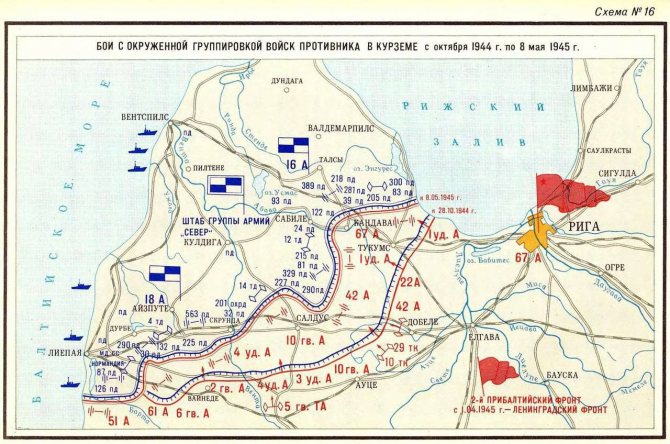

As Guderian later recalled, in February 1945, Hitler almost beat him for such proposals. Adolf Hitler flatly refused to withdraw units from the Baltic states, holding on to this "last piece of Russia." Many today doubt the psychological health of the Nazi leader and the adequacy of his decisions at the last stage of the war. One way or another, the Germans did not succeed in completely evacuating the grouping of troops from Courland to Germany; they also kept impressive forces in Norway until the end of the war. The transfer of these troops to Germany would hardly have changed the course of the battle in Europe, but it could have delayed the fall of the Third Reich.
Units of the Red Army did their best to contribute to this development of the situation, not giving the Germans a respite, conducting offensive operations and preventing the withdrawal of troops to Germany. When, in the spring of 1945, Hitler nevertheless decided to transfer troops, it was already too late to take out Army Group Courland across the Baltic Sea it took at least three months.
The first attempt to break through the line of defense of the German troops was made by Soviet troops from October 16 to October 19, immediately after the capture of Riga and the formation of the boiler itself. The headquarters of the Supreme High Command issued an order to the 1st and 2nd Baltic Fronts to immediately liquidate the Kurland grouping of enemy forces. The most successful during this period was the 1st Shock Army, which advanced along the coast of the Gulf of Riga. On October 18, the troops of this army crossed the Lielupe River and were able to capture the village of Kemeri, but the next day their offensive was stopped near the city of Tukums. The rest of the Soviet armies were unable to advance, meeting fierce resistance from the enemy, who often went over to counterattacks.
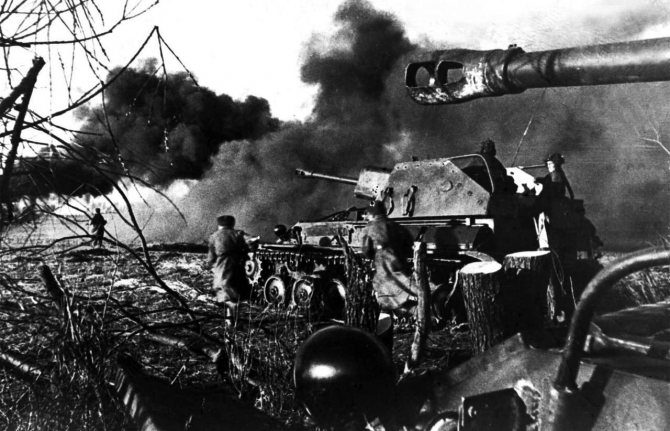

The second battle for Courland took place from 27 to 31 October 1944. The armies of the two Baltic fronts fought hard on the Kemeri - Gardena - Letskava - south of Liepaja line. An attempt to break through the German defenses with 6 combined arms and one tank army brought only tactical successes. By November 1, 1944, a crisis began in the offensive, caused by large losses of equipment, people and the depletion of ammunition stocks.
The third attempt to break through the front in this sector was made from 21 to 25 December 1944. The spearhead of the blow of the Soviet formations this time was aimed at the city of Liepaja. However, even now the offensive has failed.
The fourth offensive operation in this direction, called the Priekuli operation, took place from 20 to 28 February 1945. After conducting large-scale artillery preparation and inflicting heavy bombing strikes on the enemy by front-line aviation, Soviet troops managed to break through the front line in the Priekule area. The forces of the 6th Guards and 51st armies took part in the offensive, which were opposed by the German 11th, 12th, 121st and 126th Infantry Divisions from the 18th Army. On the first day of the offensive, Soviet troops were able to advance to a depth of 2-3 kilometers with the hardest battles. On the morning of February 21, right-flank formations from the 51st Army were able to occupy Priekule, but even here the advance of the Red Army did not exceed two kilometers. The main nodes of the enemy's defense were tanks dug into the ground along the tower. According to the memoirs of General M.I. Kazakov, only large-caliber artillery (shells for which were sorely lacking) and air bomb strikes could effectively fight the dug-in tanks.
The enemy's resistance was growing, he brought in fresh divisions of the second and third echelons into battle, using also the "Courland fire brigade", which was represented by the 14th Panzer Division.The 126th Infantry Division, seriously battered in battles, was replaced on February 24 by the Germans with the 132nd Infantry Division, after which they managed to stop the advance of the Soviet troops; by February 28, the Red Army's offensive operation was interrupted. By the evening of that day, the formations of two Soviet armies: the 6th Guards and 51st, reinforced by the 19th Panzer Corps, were able to expand the breakthrough in the German defense to 25 kilometers along the front, moving 9-12 kilometers deep into the cauldron. The troops managed to reach the Vartava River, completing the immediate task of the armies. However, the Soviet troops could not develop a tactical success into an operational one and make a breakthrough to Liepaja, to which there was another 30 kilometers, because they lacked strength.
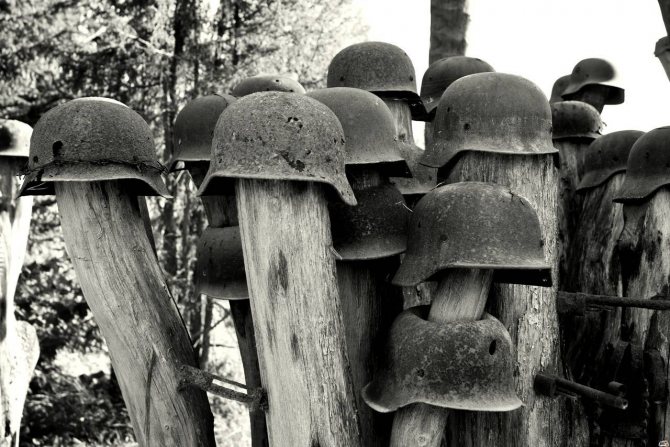

The fifth attempt to defeat the Kurland group of German troops was made in March. From 17 to 28 March 1945, the last major battle took place here. Soviet troops sought to break through the German defenses south of the city of Saldus. By the morning of March 18, the advance of the Red Army units was in two ledges, directed deep into the German defense. Some of the advancing units were able to achieve serious successes, but were forced to retreat. This was due to attempts by the enemy to surround them. At the same time, the 8th and 29th Guards Rifle Divisions were nevertheless surrounded in the area of the village of Zeni. On March 25, 1945, the 8th Guards (Panfilov) Division was surrounded by the enemy, after which it was forced to conduct heavy battles for two days. Only on March 28, the surrounded Soviet units were able to break through the encirclement and return to their own. On April 1, 1945, part of the troops from the disbanded 2nd Baltic Front was transferred to the Leningrad Front. It was he who was entrusted with the task of further blocking the surrounded German troops.
Despite the announcement of Germany's unconditional surrender, the Kurland group continued to resist Soviet troops until May 15. By this date, in the cauldron, apparently, all large centers of enemy resistance had been suppressed. At the same time, the mass surrender of German troops began as early as 23:00 on May 8. By 8 o'clock in the morning on May 10, 1945, arms were laid down and surrendered to the mercy of the victors, 68,578 German soldiers and non-commissioned officers, 1982 officers and 13 generals, led by the commander of the Kurland Army Group Karl August Hilpert. Together with him were captured the commander of the 18th Army, Lieutenant General Bege and the commander of the 16th Army, Lieutenant General Volkamer. In total, according to various sources, from 135 to 203 thousand soldiers and officers of the German army were taken prisoner, including about 14 thousand Latvian volunteers.
Despite the declaration of surrender, the Germans continued to evacuate their units from Courland to German territory. On the night of May 9, the Germans sent two convoys of 23 ships and 27 boats of the 14th guard flotilla from the port of Liepaja, a total of 6,620 people left on them. Some time later, the third convoy of 6 ships departed from Liepaja, with 3870 people on board. About an hour later, the 4th convoy, which consisted of 19 torpedo boats, managed to leave the port, onto which 2 thousand more people were loaded. During the exit to the Baltic Sea of the fourth convoy, the vanguard units of the Soviet troops entered the city. After that, the evacuation from Liepaja was naturally stopped. From the port of Ventspils, the Germans also managed to send two convoys, consisting of 45 landing barges and 15 boats, on board which were 11,300 soldiers and officers of the German army.
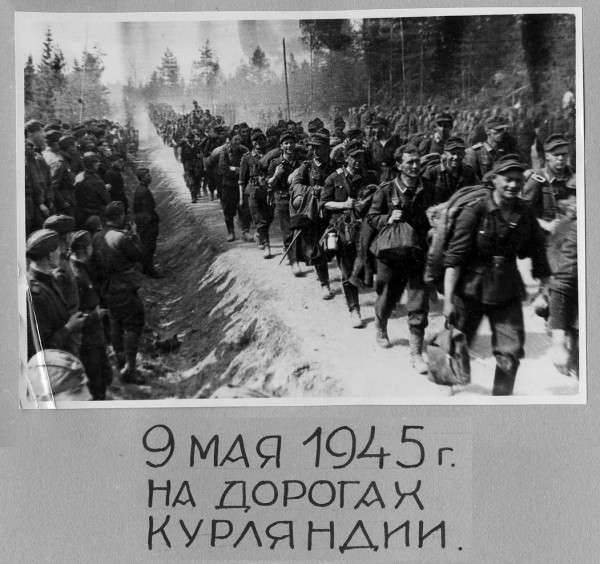

Those who did not want to surrender and did not manage to get on the last convoys leaving Courland had no choice but to go into the forests and make their way to East Prussia. According to some reports, scattered enemy units, wandering through forests and swamps, continued to resist Soviet troops until July 1945. Today we can say that the last shot of the Great Patriotic War sounded in Courland.It was mainly the SS fighters who strove to break through from Courland to East Prussia.
So a large detachment of SS men, numbering about 300 people, was destroyed by the Red Army on May 22, 1945. This detachment, which was trying to break into German territory, retreated under the banner of the 6th SS Army Corps, led by its commander Walter Kruger, who was eventually forced to shoot himself. In this battle, which took place after the official surrender of the Nazi troops, the Red Army lost 25 soldiers. Imagine how insulting and bitter it was for their relatives to receive funerals after the Victory. However, the soldiers and officers of the Red Army had to fight with weapons in their hands after May 9, in order not to hide from retaliation Nazi fanatics, whose hands were covered in blood. They did not allow them to leave Courland at the cost of their own lives.
Sources of information: https://russian7.ru/post/kurlyandskiy/full https://nnm.me/blogs/crash37331/kurlyandskiy-kotel-posledniy-boy-velikoy-otechestvennoy-voyny https://www.aif.ru / society / history / boy_posle_pobedy_9_maya_1945_goda_voyna_zakonchilas_ne_dlya_vseh Open source
Fire tube boiler device
The simple principle of work determines the construct. The shape of the body can be varied, but the most common shape is the cylinder. On one side there is a combustion chamber, and on the back there is a smoke exhaust system. Combustion is supported by a forced blowing device.
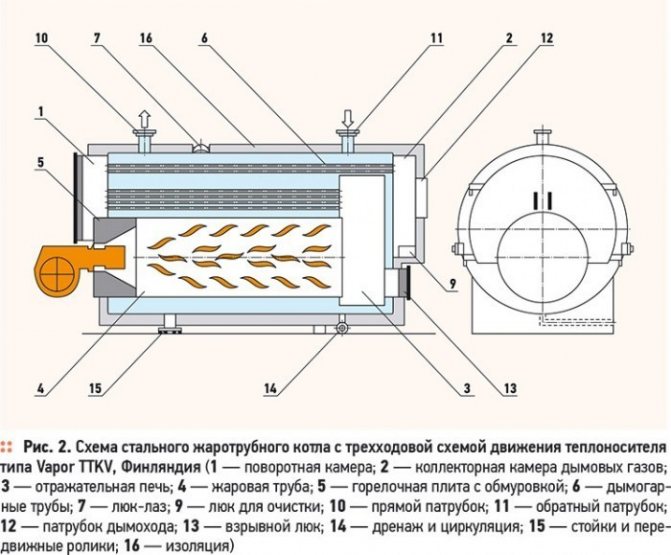

There are heat exchangers above the firebox, which are in contact with the flue duct. For increased heating efficiency, the heat exchanger is made of small section pipes. The most common three-pass fire tube boilers. Its main difference from the conventional design is the presence of three smoke ducts.
The firebox is considered the first channel, and the other two are located above one above the other. The fan provides the required draft, and there is also a natural draft through the grates and vents.
A feature of three-pass boilers is a decrease in the temperature of heated flue gases from 1000˚C to 250˚C, ensuring maximum heat transfer. But this is fraught with the fact that the water level is unstable and uncontrollable. This is solved by using a separator separating steam and water, and the droplets do not enter the collector.
In addition to the specified parts, the units are equipped with the following units to improve their characteristics:
- air outlet channels;
- steam pressure gauge;
- coolant thermometer;
- control block;
- pressure controllers;
- emergency protection.

